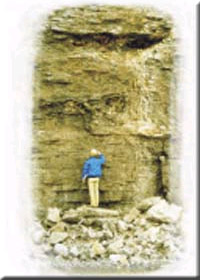

 
|
|
|
|
|
||
|
|

Movement of contaminants in rock
In 1985, polychlorinated biphenyl (PCB) oil was discovered in a shallow stormwater lagoon in the town of Smithville, Ontario. Investigations revealed that a waste transfer facility had failed, leaking PCBs and other organic contaminants into soil and bedrock, and contaminating groundwater. Fears that the town's drinking water would be contaminated prompted the closure of the municipal well, less than a kilometre away, and the installation of a pipeline to provide the community with potable water. Although the contaminated soil was excavated and destroyed and the contaminated groundwater pumped from the top of the bedrock and treated, removing contaminants from fractures in the bedrock posed a more serious problem. Relatively little is known about how PCBs and other dense, non-aqueous phase liquids move through fractured rock, and even less is known about how to remove them. What we do know is that they get trapped in fractures in the rock and when groundwater flows over them, it dissolves some of the material—making it possible for contaminants to be released into the groundwater over a long period of time. To learn more about the movement of groundwater contamination in rock, scientists from Environment Canada's National Water Research Institute, with support from the Province of Ontario and the U.S. Environmental Protection Agency, are conducting extensive research into the chemical and physical properties of the fractures and the solid rock at the Smithville site. By characterizing the variability of the rock, they are discovering more about the processes that control the migration of contaminants in groundwater. This information is crucial to the design and implementation of complex remediation strategies. 
An Environment Canada scientist studies rock fractures in an Ontario quarry. Their results show that the properties of rock are highly variable and influence the movement of contaminants. Some types act as a sponge, storing and releasing contaminants at various times. Large fractures provide pathways for contaminant transport, primarily in the horizontal direction, and evidence suggests that biological conditions in the subsurface may naturally degrade some of the contaminants. The research has produced detailed, descriptive data of the site that will be used in computer models to assess the effectiveness of various remediation methods. Because the Smithville site is similar to many contaminated sites on the American side of the Niagara River, this research will help scientists and environmental managers in Canada and the United States understand the potential for contaminants to migrate into this international river and eventually into Lake Ontario, and assist in preventing it.
|
||||||||
|
|
Home | Air | Atmospheric Science | Climate Change | Environmental Action | Habitat | Pollution | Species at Risk | Technology | Water | Weather | Wildlife |
|
|
| Help
| Search
| Canada Site |
|
||
|
The Green LaneTM, Environment Canada's World Wide Web site
|
||
|
|
||
|
|
||